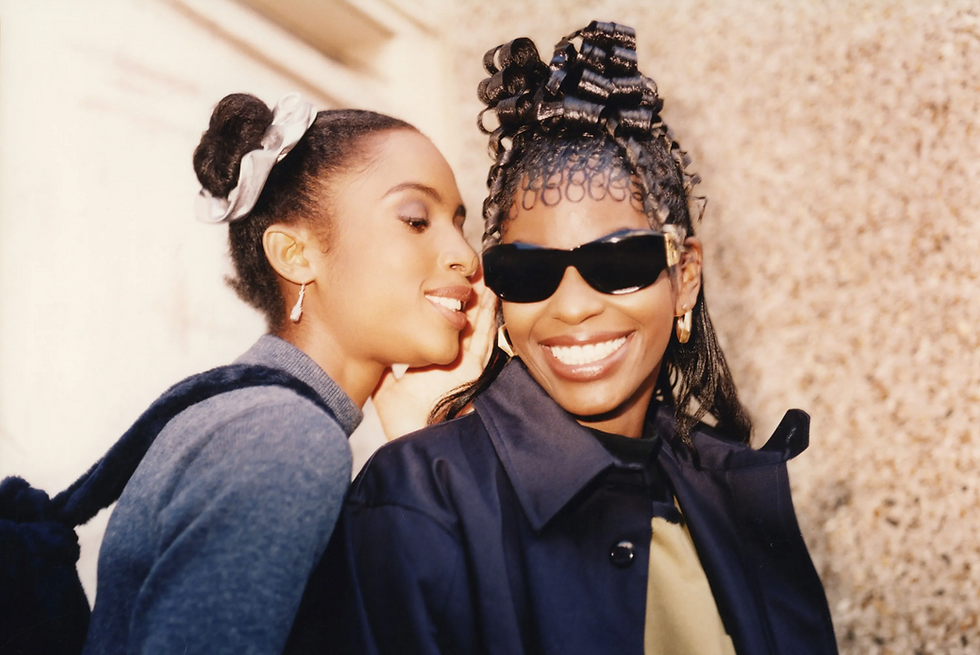Jennie Baptiste: Rhythm and Roots - Documenting culture and keeping 90s music alive
- Yellowzine

- Nov 4
- 3 min read

“I pretended to be a young press photographer!” wrote a teenaged Jennie Baptiste. The little notebook is kept in a glass box beside magazine covers and articles, each featuring her work, underneath a photograph she took of Nas in his Illmatic era. Too broke to purchase a record at the time, the brief account is rather comical to see in an exhibition at Somerset House dedicated to decades of her photography. Now, for Baptiste, her imagination has become reality. With a career starting in the late 80s, Jennie Baptiste’s documentation of the emerging music, fashion and youth culture have been foundational in representing Black British identity at the time.
Baptiste reminds us what it takes to build such an iconic foundation for photography and calls to question what it is to capture cultural and identity defining moments. As she says, "this exhibition is a personal reflection on my journey as a photographer and a celebration of the vibrant, ever-evolving culture within the Black British community. Through my lens, I’ve sought to capture the energy, resilience, and creativity that has shaped youth culture, music, and fashion.”

Baptiste’s career is a testament to the art of photography, from filling scrapbooks with inspiration to producing photographs for magazine covers. Her study of the craft in her teen years and early adulthood laid a personal foundation that she put into practice as she sought out opportunities to take the perfect shot. The exhibition itself pays homage to this journey in development, showcasing her work from the early 90s to the late 2000s. Upon entry, her ongoing series Dancehall fills the wall. Despite being still shots, the ragga dancer’s motion remains visible on film. Her black and white Jay-Z photographs depict duality; encapsulating the vulnerability of the musician’s youth on one hand and the bravado of his stardom on the other. A shoot for Pride magazine stands tall between her Black Chains of Icon shots; both tributes to 90s fashion and style.
At the end of the exhibition is a room dedicated to the DJs that were pivotal to Baptiste’s career. For her, this series was purposeful divergence from the usual documentation of musicians, who were already known celebrities in the culture. Instead, she focused on recognizing the masters behind the mixing. Slipping on the headphones placed around the room’s perimeter transports you back to the 1989 to 2003 era, with each playing sets dedicated to the likes of DJ Misbehaviour, DJ Shortee Blitz, 279 and many others. In the centre is a turntable from Revolutions @ 33 1/3rpm which, like her notebook, is a tangible tribute to her time spent in record shops like HMV.

There is still something universal about Baptiste’s photography career that transcends the passage of time; her continuous experimentation with her craft. This is what sets her apart from simply capturing the world around her. Her style maintains the animated lives of her subjects. Instead of shooting in the club or streets as typically done for documentation-style photography, Baptiste brought dancehall fans and enthusiasts into the studio. By doing this, she captured the vibrant, bold, confident community in a new way. Even while posed, there is a remaining sense of authenticity in how she chooses to direct each subject. Her use of layering negatives and superimposition to create illusions and motion or using paint to create shadow and contrast, in the case of her shots of Roots Manuva, brings each photo to life. As a result, Baptiste’s work does more than documentation, it keeps the era alive.
Video, photography, events and celebrity have become increasingly more accessible since the beginning of Baptiste’s career. People have begun to seek out the tangibility of digital cameras and film to create a sense of nostalgia. However, the photographers of the 90s and the early 2000s – Jennie Baptiste, Simon Wheatley, Normski, Dennis Morris sought to keep the moment they were in alive, they were led by interest and inspiration. Where the music they loved went, they followed. Maybe that’s what made the era so special. Their recognition that capturing now was as important as yearning for yesterday. Maybe that’s what encouraged teenage Jennie Baptiste to hang out in record shops and pretend to be press just for a photograph.
Jennie Baptiste: Rhythm & Roots is running at Somerset House in London until 4 January. You can get tickets here.
Written by Mayowa Amolegbe







Comments